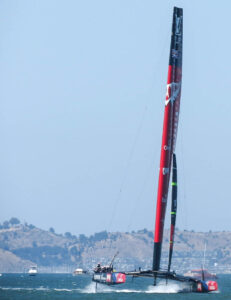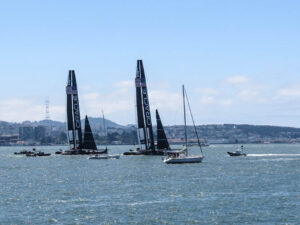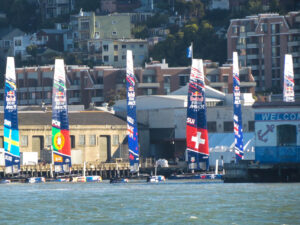The America’s Cup boat race is entering the last leg of a long journey and it’s now down to BMW Oracle and Emirates New Zealand. These boats have pushed the limits of design and their sailors are pushing themselves to win. Each America’s Cup series pushes the limits of design, humans, and physics.
Suddenly, San Francisco is gaga over boat races. Obviously, this rich town on the Bay has always had a high proportion of yacht-people but not all those people know their stern from their aft. They do know big drama though, and the America’s Cup has plenty of that—just not necessarily on the water. The America’s Cup is about exploring the furthest boundaries of sanity in design and in gamesmanship.
As befits a race designed by and for the fabulously wealthy, the rules of the game shift according to the whims of the winner, and the game starts long before the boats hit the water for the final races in the America’s Cup. In September 2010, after winning the America’s Cup race in February in Valencia, Spain, the U.S. team BMW Oracle claimed their right to dictate the terms of the next America’s Cup race, and to no one’s surprise team leader and Oracle CEO Larry Ellison named San Francisco as the site of the race. The BMW Oracle team also decreed that the race would be run using a new class of boat, the AC72, which is so named for its length—it’s about 72 ft. long.
Before the races came to the U.S. for the finals, the Louis Vuitton Race, and the America’s Cup Race were held using smaller versions of the AC72, the AC45. The boats used in the AC45 races are supposed to be identical and so the races are seen as tests of the sailors. The giant showboats, the AC72s, can be optimized for speed, and all the world’s knowledge about boat design, aerodynamics, fluid dynamics, physics, weather patterns, and every tiny butterfly flap that might have an influence, comes to bear on the design of these boats. The final races of the AC72s are determined finally by the skills of the sailors and the superiority of the boats’ design.
The AC72 boats have been criticized as being too expensive to build, thus limiting the number of potential contestants in what is already a very elite field. In the very optimistic months before the race promoters talked about a field of 14 or 15 boats vying for the America’s Cup, but as the July 4 kickoff race deadline drew near, only four challengers had stepped up: Italy’s Luna Rossa, Sweden’s Artemis, Korea’s White Tiger, and Emirates New Zealand. Korea would eventually drop out.

When these boats hit their stride, they raise out of the water onto hydrofoils; that’s when they mean business, almost flying across the water like something from the future. They’re just beautiful and that’s what sets this 34th running of the America’s Cup apart. It’s the first America’s Cup to feature these huge, grand hydrofoiling catamarans.
Reality sets in
The AC72s are the fastest boats in the world and they’re dangerous. During practice runs, one of the Swedish boats capsized and Andrew Simpson was trapped in the water and died. After all the posturing and taunting of rich men and rich countries boasting about their expensive super boats, it was a horrible infusion of reality. The sad overturned Artemis stayed adrift in the water for a long time, a reminder that rich men’s games can have high price tags. Race officials dictated 37 new restrictions for safety. There were dark mutterings, New Zealand and Italy protested two of the new rules, which ironically, were fairly permissive rules allowing changes to make the boats more stable while foiling out of water and Sweden’s Artemis, which suffered the most, protested the protest.
In the end, only New Zealand and Italy remained to run the Louis Vuitton races and compete for the right to race Oracle in the final America’s Cup race. Late to the race, the Italian team had to scramble to raise funds and get a boat. They got some funding from the government and from backer Prada. The Luna Rossa team then opted to buy the design package for their boat from New Zealand and they started getting familiar with the boat in the waters off Auckland. New Zealand won handily and, by America’s Cup standards’ the Luna Rossa team accepted their loss with grace only gently pointing out that they had entered the race over a year late and did not have time to modify their boat design the way they would have liked.
Luna Rossa’s helmsman Chris Draper is widely quoted online saying, “our boat is a first generation and the boats aesthetically look similar, but there are quite a few differences. If we had the opportunity to redesign things, then there are things we would’ve designed differently, which I imagine are the things they’ve done differently with their second boat. At the same time, there’s not another design package we would’ve chosen to share.” The New Zealand team and the Italian teams have been friendly competitors and after their loss in the Louis Vuitton Cup, Luna Rossa offered to help the New Zealanders train to go up against Oracle.

Throughout the Louis Vuitton semi-final races, alongside all the private yachts, sail boats and charters, the Oracle boats would occasional sally forth as silent observers—big, black forbidding reminders of the coming challenge, Oracle against the world.
Boat Design
They’re all stars, these people who have risen through their fields to tackle some of the most challenging design problems in the world. They move around the very elite club of designers who work on America’s Cup boats. The AC72s developed for this 2013 race has adopted the multi-hull and fixed sail design favored by Oracle and the foiling design flaunted by New Zealand. Their famous foils are dagger boards, retractable keels that descend from the catamarans’ hulls. The horizontal section lifts the hull out of the water for reduced drag and faster speed. The vertical board helps fight the wind’s sideway push. Advances in carbon fiber have also made a huge difference in the recent America’s Cup designs. They’re lightweight boats that can react to light winds and are being raced close to shore. They’re designed for speed and to thrill the crowds as well as the racers.
The fixed sail has some flexibility which can be adjusted to minute degrees and it also includes flaps to optimize the shape. When the TV cameras on helicopters zoom in close during the race, they zoom on the men who madly grind the wheels that adjust the sails according to precise geometry calculations that are spelled out on computer screens on the boats. Oracle boat designer Ian Burns told Popular Mechanics, “you can be changing those controls every second.” The sailors have to understand aerodynamics, just as the boat designers understand sailing.
Naval Designer Roberto Biscontini is part of the Luna Rossa team and he has also worked on earlier Oracle design teams. Most of Biscontini’s customers come to him for help designing boats for the America’s Cup and the Volvo Ocean Race. He also has some very exclusive private customers. In fact, he said in an interview, “the changes happening in race design is being driven by private money, which is transforming the design teams for competitions like America’s Cup and the Volvo Race.” The new breeds of teams are made up of professionals who are the best at what they do from all over the world, and they come together for these projects. In the years leading up to the race, design teams are distributed in different countries and they collaborate with each concentrating on their areas of expertise such as sails, masts, materials, and analytic studies.
“Until a few years ago, we all had to relocate for long periods, while today traveling is minimized, basically limited to the moment when the sailing yacht is put into water,” says Biscontini, who adds that technologies including computer-based design, email, and cloud technology are coming together to improve the workflow.
Biscontini uses Siemens NX for the design and says that a characteristic of design on today’s America’s Cup yachts is that the designs rely on parameterization, creating 3D parts that are repeated, refined, and reused. Biscontini notes that as the America’s Cup race moved from traditional monohull sailing yachts to modern wing-sailed catamarans, the designs have further incorporated elements similar to airplane wings. Of the fix sails for instance, says Biscontini, their behavior is more stable and more predictable than fabric sails, so you can study and simulate them even better with CAD.
New Zealand, which has won the America’s Cup twice, has gracefully made the shift from being the top monohull team in the world to multihulls. As this is being written, Emirates New Zealand is putting up a fierce fight to win the America’s Cup race and currently leads. The New Zealand team is also unique in its decision to go for a purely digital process in their design iterations relying completely on simulations in lieu of experiments using physical prototypes in water tanks. The team used Ansys computational fluid dynamics to test up to 750 operating conditions per design. Simulation tools also played a big role in refining the design of the wing, the main rigid sail, and to test its interaction with the headsail and the body of the yacht. New Zealand’s design was developed to optimize the aerodynamics of the yacht’s platform with the wing and the sails.

The Oracle design team has signed up some of the designers who also worked on the winning boats for the Alinghi team of Switzerland. At one point Alinghi was declared the winner in the 2010 America’s Cup race but Oracle and the Golden Gate Yacht Club protested on a rules technicality and Oracle beat Alinghi in a court-ordered special match held to decide the winner. In that match Oracle’s use of a fixed sail proved to be a huge advantage.
The Oracle Design team is led by France’s Michel Kermarec and Mario Caponnetto, both of whom have backgrounds in propeller designs. Caponnetto leads the work done on computer fluid dynamics. Caponnetto has talked about using visualization and simulation tools from CD Adapco to optimize the design of the wing and use the visualizations to help train sailors used to traditional sailing to adapt to the fixed wing design of this new generation of boats.
Andrew Mason who had worked on winning boats for the Alinghi team of Switzerland has come on board with Oracle to perfect the hull design. Mason uses genetic modeling to ‘breed” a better design. His methods were used to develop the monohulls used to enable Alinghi to win the America’s Cup in 2007. Mason developed the MaxSurf design program for yacht design in the mid-80s, which was acquired by Bentley Systems and is now part of the that company’s FormSys product line for naval design. Mason has also talked about using open source tools for simulation including OpenFlow for CFD. His point is that designers are taking advantage of every available resource to improve designs. Mason has talked about the huge difference the use of multiple GPUs make on the ability to design America’s Cup boats because from his point of view, the more iterations he can make, and the faster he can make them, the better.
But after all the discussion, the development of these amazing machines are not about individual tools. They’re the culmination of more than a century and a half of sailing experience enhanced by scientific understanding of wind and waves and augmented by human strength and daring. None of it comes down to one piece of the design, and it can all be undone by the work done by the men on the boat.
The games have begun
As the races come closer to the final conclusion, the odds have shifted dramatically. Oracle, those forbidding observers of the Louis Vuitton race, suddenly turned into underdogs after the America’s Cup Finals went into their first weekend. Oracle lost the first two races on Saturday the 8th and only won one the next day.
To make matters worse, the results of those early races using the AC45s were tainted when in preparation for the Red Bull Youth America’s Cup races, one of Oracle’s AC45 was discovered to have been illegally modified—weight had been clumsily added to the base of the fixed wing. Did the modifications have anything to do with Oracle’s wins in those races? Did the modifications happen with the knowledge of the team’s management? In the end an international jury’s decision was that Team Oracle didn’t know anything about the modifications and that it would not have affected the outcome of the series. On the other hand, cheating is cheating and Oracle was fined $250,000, two sailors were expelled, and Oracle was forced to cede two races to New Zealand.

The end game is here and Oracle is in the hole but the truth of the matter is that the race was started immediately after the conclusion of the America’s Cup 2010 with Oracle’s win. Oracle’s Larry Ellison chose the fabulous, and fabulously expensive, AC72’s and with that choice raised the already high price of entry for America’s Cup races into the stratosphere. At the same time, Ellison and the Golden Gate Yacht Club have helped to democratize the race. Oracle brought the race to San Francisco; given the layout on San Francisco Bay, for the first time the races are close to shore where regular people can watch. And, those AC72s flying across the water are a mighty fine sight to see. Those strongmen bouncing on their trampolines from side to side, cranking like madmen to grab the wind, well they’re a mighty fine sight to see as well.





